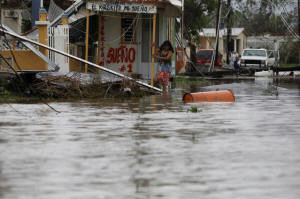|
Failing dam creates new crisis on Puerto
Rico amid flooding from Hurricane Maria
 Send a link to a friend
Send a link to a friend
 [September 23, 2017]
By Dave Graham and Robin Respaut [September 23, 2017]
By Dave Graham and Robin Respaut
SAN JUAN, Puerto Rico (Reuters) - Emergency
officials in Puerto Rico raced on Saturday to evacuate tens of thousands
of people from a river valley below a dam in the island's northwest,
which is on the verge of collapse under the weight of flooding in the
aftermath of Hurricane Maria.
The potential calamity was unfolding as Puerto Ricans struggled without
electricity to clean up and dig out from the devastation left days
earlier by Maria, which has killed at least 25 people across the
Caribbean, according to officials and media reports.
Some 70,000 people live in a cluster of communities under evacuation
downstream from the earthen dam on the rain-swollen Guajataca River,
Puerto Rico Governor Ricardo Rossello said in a late-afternoon news
conference on Friday.
Residents of the area were being ferried to higher ground in buses,
according to bulletins issued by the National Weather Service from its
office in San Juan, the capital of the U.S. island territory.
Christina Villalba, an official for the island's emergency management
agency, said there was little doubt the dam was about to break.

"It could be tonight, it could be tomorrow, it could be in the next few
days, but itís very likely it will be soon," she told Reuters by
telephone on Friday night. She said authorities aimed to complete
evacuations within hours.
Governor Ricardo Rossello went to the municipality of Isabela on Friday
night and told mayor Carlos Delgado that an evacuation there was urgent,
his office said in a statement.
Rossello said the rains sparked by Maria had cracked the dam and could
cause fatal flooding.
Puerto Rico's national guard had been mobilized to help the police
evacuate all necessary areas, Rossello said.
People had begun leaving nearby areas, but one small community was
refusing and Rossello instructed the police to step in under a law that
mandated them to remove the local population in an emergency, the
statement said.
Villalba could not say how many people had already been evacuated, or
how authorities were communicating with residents to organize the
evacuation.
PATH OF DESTRUCTION
Maria, the second major hurricane to savage the Caribbean this month and
the most powerful storm to strike Puerto Rico in nearly a century,
carved a path of destruction on Wednesday. The island remained entirely
without electricity, except for emergency generators, two days later.
Telephone service was also unreliable.
Roofs were ripped from many homes and the landscape was littered with
tangles of rubble, uprooted trees and fallen power lines. Torrential
downpours from the storm sent several rivers to record flood levels.
Officials confirmed on Friday at least six storm-related fatalities in
Puerto Rico, an island of 3.4 million inhabitants - three from
landslides in Utuado, in the island's mountainous center, two drownings
in Toa Baja, west of San Juan, and a person near San Juan who was struck
by a piece of wind-blown lumber.
Earlier news reports had put the island's death toll as high as 15.
"We know of other potential fatalities through unofficial channels that
we haven't been able to confirm," said Hector Pesquera, the government's
secretary of public safety.
[to top of second column] |

A woman tries to walks out from her house after the area was hit by
Hurricane Maria in Salinas, Puerto Rico, September 21, 2017.
REUTERS/Carlos Garcia Rawlins

DEBT CRISIS
Maria struck Puerto Rico as a Category 4 storm on the five-step
Saffir-Simpson scale as the island was already facing the largest
municipal debt crisis in U.S. history.
The storm was expected to tally $45 billion in damage and lost
economic activity across the Caribbean, with at least $30 billion of
that in Puerto Rico, said Chuck Watson, a disaster modeler at Enki
Research in Savannah, Georgia.
Elsewhere in the Caribbean, 14 deaths were reported on Dominica, an
island nation of 71,000 inhabitants. Two people were killed in the
French territory of Guadeloupe and one in the U.S. Virgin Islands.
Two people died when the storm roared past the Dominican Republic on
Thursday, according to media outlet El Jaya.
Maria churned past the Turks and Caicos Islands on Friday, then
skirted away from the Bahamas, sparing both from the brunt of the
storm, according to the U.S. National Hurricane Center.
It still had sustained winds of up to 120 miles per hour (195 km/h)
on Saturday, making it a Category 3 hurricane, but was expected to
weaken gradually over the next two days as it turned more sharply to
the north.
Storm swells driven by Maria were expected to reach the southeastern
coast of the U.S mainland on Friday, the NHC said, although it was
too soon to determine what, if any, other direct effects it would
have.
Maria passed close by the U.S. Virgin Island of St. Croix, home to
about 55,000 people, early on Wednesday, knocking out electricity
and most mobile phone service.
It hit about two weeks after Hurricane Irma pounded two other U.S.
Virgin Islands, St. Thomas and St. John. The islands' governor,
Kenneth Mapp, said it was possible that St. Thomas and St. Croix
might reopen to some cruise liner traffic in a month.

Irma, one of the most powerful Atlantic storms on record, killed
more than 80 people in the Caribbean and the United States. It
followed Harvey, which also killed more than 80 people when it
struck Texas in late August and caused flooding in Houston.
(Reporting by Dave Graham and Robin Respaut in San Juan; Additional
reporting by Jorge Pineda in Santo Domingo, Nick Brown in Houston,
Devika Krishna Kumar and Daniel Wallis and Jennifer Ablan in New
York and Alex Dobuzinskis in Los Angeles; Writing by Scott Malone
and Steve Gorman; Editing by Andrew Bolton)
[© 2017 Thomson Reuters. All rights
reserved.]
Copyright 2017 Reuters. All rights reserved. This material may not be published,
broadcast, rewritten or redistributed. |